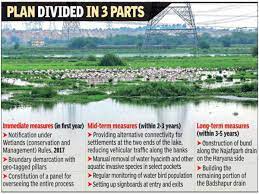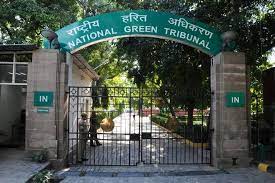27 Jan 2022 Environmental management plan

- Recently the National Green Tribunal (NGT) has directed Delhi and Haryana to implement the Environment Management Plan (EMP) prepared by both the governments for the rejuvenation and conservation of Najafgarh Lake, a transboundary wetland (wetland).
- The implementation of these Action Plans is to be monitored by the National Wetland Authority through the State Wetland Authorities.
- Earlier, the Union Environment Ministry had constituted a three-member committee to prepare the EMP in an integrated manner.
Environmental Management Plan:
- Notifying the Najafgarh Lake and its area of influence will be the topmost priority under the Wetlands (Protection and Management) Rules, 2017.
- These rules restrict and regulate certain activities within wetlands and their ‘zone of influence’.
- It lists immediate measures including demarcating the extent of wetlands using geo-marked columns and introducing hydrological assessment and species listing.
- Medium-term measures to be implemented over two to three years include in-situ treatment of major drains from Lake Najafgarh, regular monitoring of waterfowl populations and relocation of flow barriers such as power sub-stations.
- This lake is known as the habitat of migratory and resident waterfowl.
- It also proposes a detailed estimate of sewage generation in the area, taking into account 15 years of estimated population, and the identification of all drains that contribute to pollution in the lake.
Najafgarh Lake:
- It is situated in a natural depression/concave land in South-West Delhi near Gurugram-Rajokri border on National Highway-48.
- This lake is largely filled with sewage (sewage) coming out of villages around Gurugram and Delhi. A part of the lake comes under Haryana.
- The presence of 281 bird species has been reported in the lake, including the Egyptian Vulture, Stork Crane, Steppe Eagle, Greater Spotted Eagle, Imperial Eagle, among many endangered and migratory birds along the Central Asian Flyway.
Related concerns:
- Due to large scale encroachment, the water body spread in Delhi and Gurugram is only seven sq.km. Which was once reduced to 226 sq km.
- According to the Indian National Trust for Art and Cultural Heritage (INTACH), the revival of the lake will produce about 20 million gallons of water a day to support a population of 3.5 lakh.
- INTACH is a non-profit organization registered under the Societies Registration Act, 1860.
- Despite being a source of many benefits and permanent habitats of diverse species, the Najafgarh Lake has become highly fragmented and transformed, has undergone various types of construction work, has been used for waste disposal as well as various invasive species.
- Najafgarh Lake was a natural floodplain of the Sahibi River, it has now been converted into a drain. The settlements of Haryana and Delhi are at high risk of floods due to loss of wetlands and their ground water level has also decreased.
- Recent constructions within wetlands have caused high seismicity and liquefaction within the area, disrupting natural wetland functions.
Importance:
- Najafgarh Lake is an important natural infrastructure for the region, which buffers floods, treats wastewater, recharges groundwater (with high potential to supply water to significant populations) and supports many plant, animal and bird species provides accommodation.
- Being a heat and carbon sink, it can control the microclimate. In fact, if EMPs are properly and fully implemented, this lake could become the focus of the National Capital Region’s ability to mitigate the local impacts of climate change.
National Green Tribunal:

- It is a special body established under the ‘National Green Tribunal Act’ (2010) for effective and speedy disposal of matters related to environmental protection and conservation of forests and other natural resources.
- With the establishment of the ‘National Green Tribunal’, India became the third country in the world after Australia and New Zealand to set up a Special Environment Tribunal and also the first developing country to do so.
- The ‘National Green Tribunal Act’ (2010) has given a special role to the Tribunal to deal with issues where disputes arose under seven specified laws (mentioned in Schedule I of the Act)- Water Act, Water Cess Act , Forest Conservation Act, Air Act, Environment Protection Act, Public Liability Insurance Act and Biological Diversity Act.
- NGT is headquartered in Delhi, while the other four regional offices are located at Bhopal, Pune, Kolkata and Chennai.
Wetlands:
- Wetlands are seasonal or permanent ecosystems located in water. These include mangroves, swamps, rivers, lakes, deltas, floodplains and floodplains, rice fields, coral reefs, marine areas (places with high tides less than 6 m) as well as man-made wetlands such as waste-water treatment ponds and Reservoir etc.
- Wetlands cover about 6% of the total land surface. 40% of all species of plants and animals live in wetlands.
- It is the transition zone between water and land.
- February 2 is World Wetlands Day. The Ramsar Convention on Wetlands in Ramsar, Iran was adopted on this date in the year 1971.


No Comments